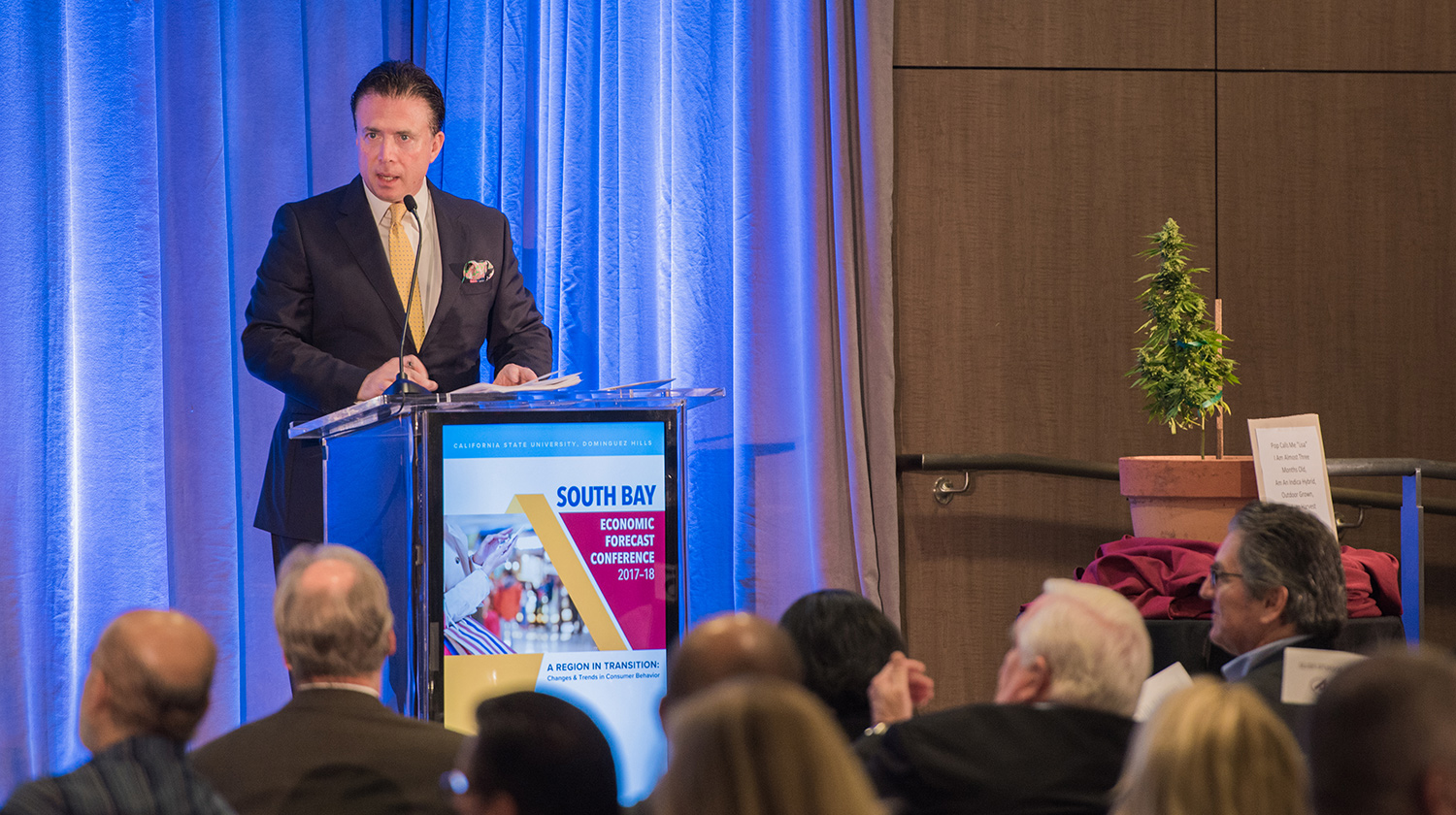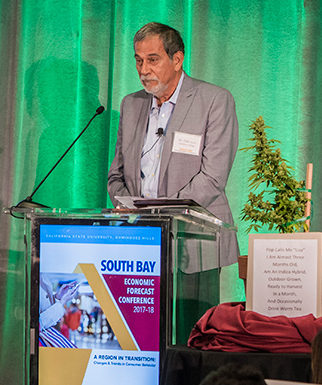
Despite a slower pace of job creation in 2016, the South Bay has remained an “engine of growth in Los Angeles County” with employment at a record high, and many industries adding jobs and offering higher wages.
That positive, yet reserved, description of the South Bay’s economy was derived from California State University, Dominguez Hills’ (CSUDH) report “A Region in Transition: Changes and Trends in Consumer Behavior,” which was released and analyzed on Oct. 5 during the university’s 2017-18 South Bay Economic Forecast.
Hosted by Frank Mottek, anchor for KNX 1070 NEWSRADIO, the economic conference provided a comprehensive, data-driven report on the current state of the South Bay and Los Angeles County economies, as well as the outlook for 2018. Robert Kleinhenz, executive director of research at Los Angeles-based Beacon Economics, the independent research and consulting firm that developed the report for CSUDH, presented the economic report’s findings during the forecast.
“The (South Bay) economy has effectively reached full employment, but this doesn’t mean we will stop growing. Rather, we will proceed at a more measured pace in 2018,” said Kleinhenz.

Brass Tacks
According to Kleinhenz, CSUDH’s economic report found, on average, that South Bay employees made $62,200 in annual wages in 2016, representing a 2.7 percent gain over the previous year. The region’s workers are disproportionately employed in high-skill industries, resulting in the average South Bay worker making 3.9 percent more than the average Los Angeles County worker.
The report also showed that while “declining taxable sales in the area suggest slowing business expansion,” the Ports of Los Angeles and Long Beach are “poised for a record year in container activity” and the broader transportation and logistics sector is “humming with activity.” At the same time, real estate markets continue to advance with higher home prices due to tight supplies.
“Home ownership rates are at the lowest rates in decades and rents are escalating,” Kleinhenz explained. “We’re just not building enough. It’s really about supply. We just need to increase the supply of homes to accommodate population growth.”
Like the South Bay and the entire State of California, Los Angeles County has seen slower growth so far in 2017 when compared with prior years, which may be attributed in part to a very tough labor market. However, key industries continue to show job gains, taxable sales are on the rise, and the county’s unemployment is lower than it has been in decades, according to the report.
High-Flying Industries
In the South Bay, the economic report found “business creation to be strong over the past 10 years, with a net increase of 16,348 ï¬rms operating in the South Bay between 2007 and 2016,” and a total of 45,892 businesses operating in the South Bay as of last year. However, the region did experience a net loss of business creation–320 less in 2016–which occurred in health care, wholesale trade, and in the professional, scientiï¬c and technical services sectors for the most part.
To provide a sample of the South Bay’s and L.A. County’s economic prowess, several innovative businesses were represented during the economic forecast. During presentations, company officials shared their business models, successes and growth plans, and data related to their industries, while others discussed regional and statewide business trends.
From the private sector, the speakers included Kyle Ransford, chief executive officer of the meal kit delivery service Chef’d in El Segundo; Shawn Gold, corporate marketing officer, Techstyle Fashion Group, also in El Segundo; Giancarlo Filartiga, vice president of development for Macerich Real Estate, and Christine Cooper, regional economist for the commercial real estate research firm CoStar.

The quality of faculty-led research was also on display at the conference. From CSUDH, Jose Martinez, assistant professor of economics and co-director of CSUDH’s South Bay Economics Institute, provided an update of the South Bay housing market, and changes in commuting trends. Fynnwin Prager, assistant professor of business administration and co-director of CSUDH’s South Bay Economics Institute, shared data from the institute’s research project on trends in foreign-owned businesses in Southern California.
Daniel Duran, associate professor of business administration at Whittier College, covered cannabis production and its environmental and economic impact oncities and L.A. County. He reported that the legalization of recreational marijuana use could mean thousands of new jobs in the county, a large influx of revenue, and California becoming the “largest legal pot economy” in the United States.
To enhance the audience’s curiosity, Duran brought a mature marijuana plant that he named “Lisa” to the conference, which was displayed near the stage.
“Instead of being an undercover type of product, cannabis is now legally grown to support 60 percent of the country’s population, and it will probably be closer to 70 percent by the end of next year,” said Duran. He also said that cannabis is currently estimated to generate $6 billion in annual sales a year in the U.S. “This is a wave that is taking over the country and we know pathetically little about the composition of that wave, and the impact that it has from an economic or environmental perspective. This is a huge business that needs to be professionalized.”